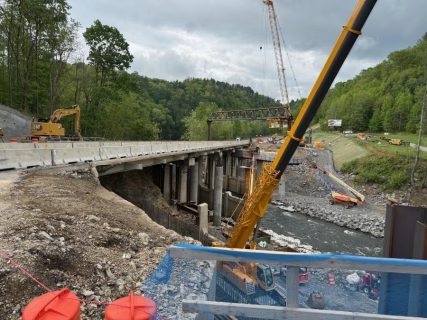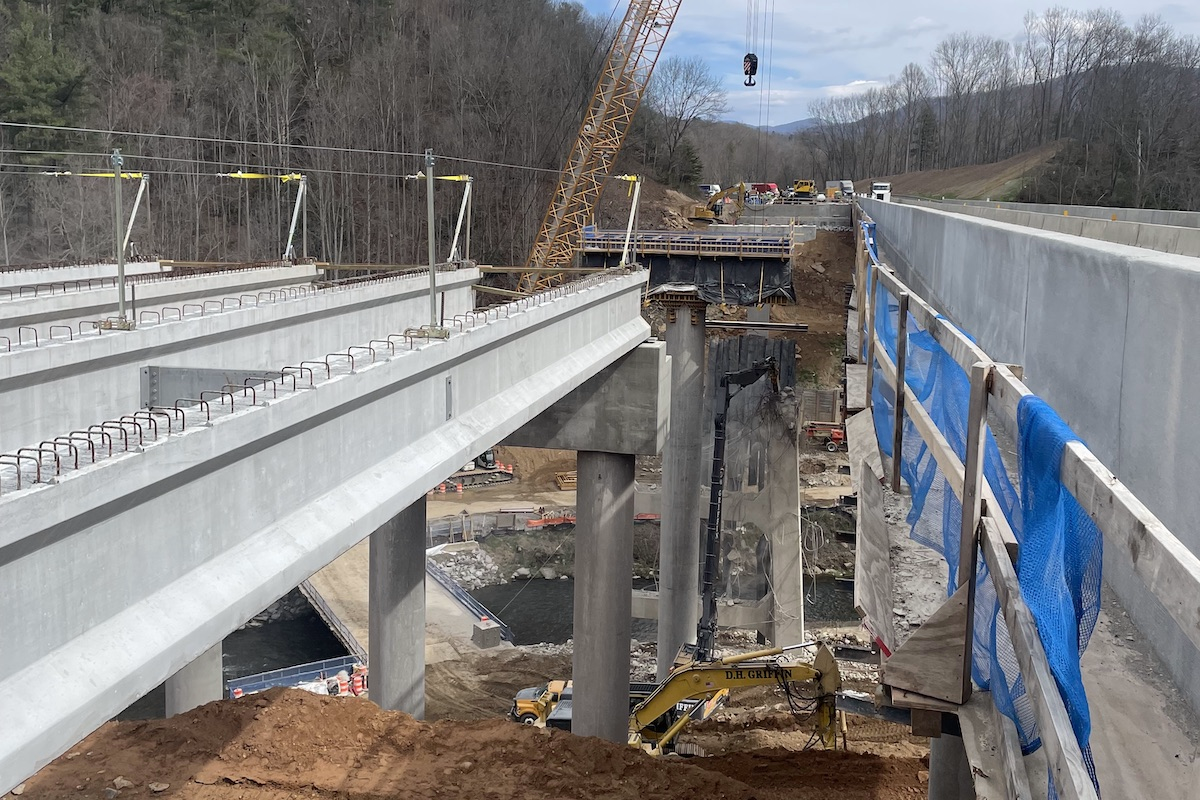Kiewit Infrastructure South is replacing Bridge 142 over the Pigeon River on Interstate 40 in North Carolina as part of a broader corridor overhaul. The $70.5 million effort is one piece of a five-bridge replacement program under the I-40 Gorge Bridges Project.
Work on Bridge 142 improves safety, traffic flow, and resilience. It supports both freight and local travel through this rugged mountain terrain. Construction is scheduled to finish in 2026.
Context: The I-40 Gorge Bridge Program
This replacement is part of Kiewit’s rollout of five aging bridges along a 13-mile stretch of I-40 through Pigeon River Gorge. All of them were built in the 1960s and now fall short of modern design standards.
Given increased traffic (43 % growth over 15 years on this corridor) and truck volumes, the replacements are now essential.
Project Factsheet: I-40 / Pigeon River Gorge Bridge Replacement
Project Name I-40 Gorge Bridges Replacement – Bridge 142 (Pigeon River)
Location Haywood County, North Carolina, USA
Corridor / Stretch 13-mile segment of I-40 through Pigeon River Gorge
Owner/ Agency North Carolina Department of Transportation (NCDOT)
Contractor Kiewit Infrastructure South Co.
Cost for Bridge 142 around $70.5 million
Overall Program Cost approximately $201 million for replacement of five bridges
Construction Start October 2021 (for initial bridges)
Estimated Completion October 2026
Bridge 142 Stats ~364 ft long, ~50 ft above river, ~81 ft width
Key Upgrades Wider shoulders, stronger crash barriers, vertical clearance, prestressed girders
Innovations Used Gantry crane system for girder placement, TyBOT rebar robot, heated curing techniques
Environmental Measures Bat boxes, wildlife fencing, jump-outs, ecological corridor planning
Major Risks & Constraints Steep terrain, limited access, river level variability, winter weather, traffic continuity
Expected Benefits Enhanced safety, reduced maintenance interruptions, improved traffic flow, ecological protection
Engineering & Construction Strategies
From the outset, the project employed the CM/GC (Construction Manager / General Contractor)delivery model. This allowed Kiewit and designers to collaborate early on sequencing, constructability, and risk mitigation.
Construction is limited to the winter off-season to reduce disruptions, protect tourism flow, and allow safer working windows. Despite steep slopes and remote access, traffic remains open via careful phasing.
On Bridge 142, the new design includes wider shoulders, stronger crash barriers, and higher vertical clearance to meet modern interstate standards. The bridge will use prestressed concrete girders and reinforced substructures to resist flooding and seismic loads.
This approach reflects a growing trend across U.S. infrastructure projects to balance modernization with resilience, as seen in California’s AB 697 legislation accelerating Highway 37 upgrades. Such initiatives prioritize safety, sustainability, and long-term climate adaptability in critical transportation corridors.
To place heavy girders (some weighing 52–71 tons), crews designed a gantry crane system to shift girders horizontally instead of relying solely on large cranes.
For rebar work on some bridges, they used TyBOT, a robotic rebar-tying machine, boosting speed and quality.

Challenges & Adaptive Solutions
The terrain is steep and access limited. Delivering materials and equipment through narrow, winding routes demanded advanced planning.
Weather is unpredictable. River levels can rise fast, and freeze-thaw cycles complicate concrete curing. The project team uses heated enclosures and specialized curing strategies to counter cold conditions.
Keeping a major traffic artery open while replacing bridges adds complexity. The team phases demolition and new work so that at least one lane remains active.
Status & Outlook
By mid-2025, Kiewit had already completed three of the five bridges. The final bridges, including 142, are due by October 2026.
Once finished, travelers will benefit from safer, smoother, and more durable crossings. Maintenance disruption will decline. Emergency and freight access will improve.

